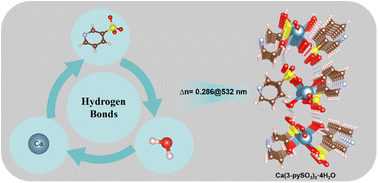Birefringent materials, capable of manipulating light polarization, are pivotal in advanced optical technologies. Traditionally, the development of such materials has predominantly focused on purely inorganic compounds, which often exhibit limited birefringence. Herein, we present a new 3-pyridinesulfonate birefringent crystal, Ca(3-C5H4NSO3)2·4H2O, synthesized via a hydrogen-bonded regulation strategy designed to enhance the coplanarity of [3-pySO3] groups. As expected, Ca(3-C5H4NSO3)2·4H2O demonstrates a notably large birefringence of 0.286@532 nm, exceeding that of most commercially available birefringent crystals. Furthermore, this compound demonstrates outstanding environmental stability and a short ultraviolet (UV) absorption cutoff edge at 257 nm, accompanied by a wide band gap of 4.4 eV. A combination of structural analysis and theoretical calculations unraveled the crucial role of hydrogen bonds in optimizing the arrangement of [3-pySO3] rings. This arrangement effectively induces a high degree of coplanarity and facilitates the formation of a quasi-2D layered structure, thereby contributing to the exceptional optical anisotropy of Ca(3-C5H4NSO3)2·4H2O. These findings highlight Ca(3-C5H4NSO3)2·4H2O as a promising UV birefringent crystal and underscore the efficacy of hydrogen bond engineering for designing new materials with enhanced birefringent properties.


